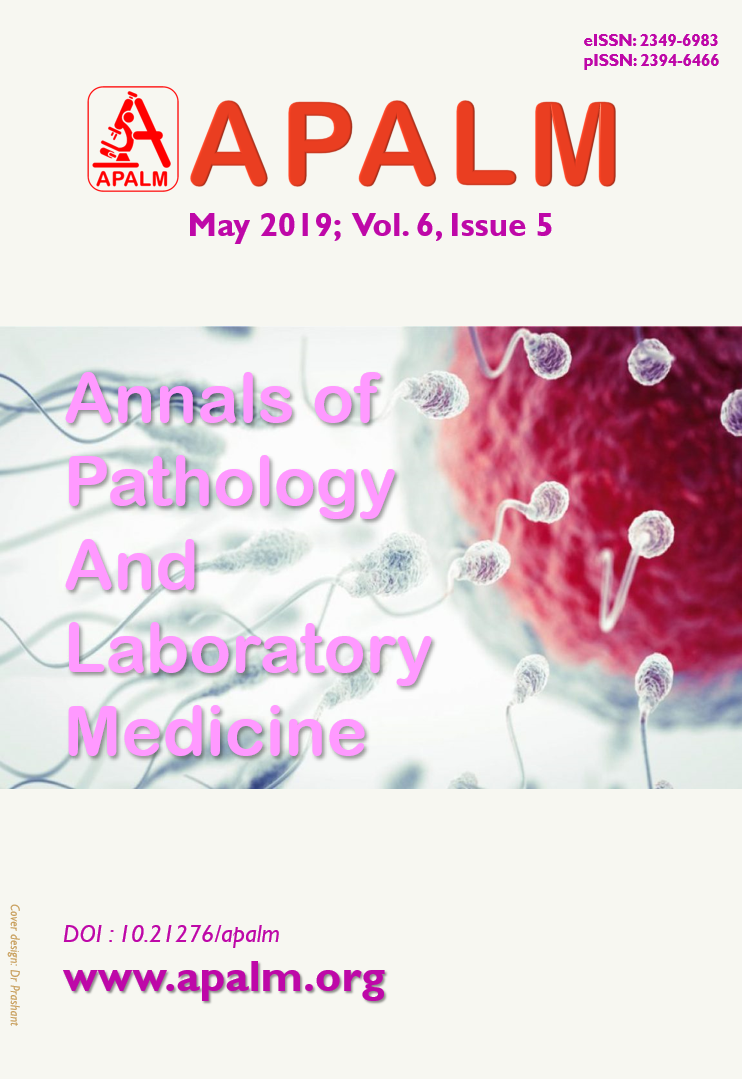Utility of Hematology Histograms
DOI:
https://doi.org/10.21276/apalm.2527Keywords:
Automated hematology analyzers, Hematology histograms, Sensitivity of histograms, Acute Febrile IllnessAbstract
Background: Over the past five decades, hematology analyzers have evolved from semi-automated to fully automated ones. A histogram is a graphic representationof a collection of data based on cell size and/or cell number depicting variations in the process.
Objective: To study hematology histograms in relation with major blood cell components and in cases of acute febrile illness.
Methods: It was a cross sectional observational study conducted over 200 consecutively collected samples from adults. Histograms were obtained from 3-part automated hematology analyzer, evaluated in relation to the RBCs, WBCs and platelets with their peripheral blood smear (PBS) picture and with the cases with diagnosis of acute febrile illness.
Results: In the present study, maximum number of samples were from 15-25 years of age group with a male preponderance. Out of 200 histograms, 102 had combined abnormality of the all 3 blood cell types in varied combinations. Neutrophilia, microcytosis and thrombocytopenia were the most common findings in the respective individual blood cell histograms. Maximum sensitivity of WBC histogram was for neutrophilia (81.08%), that of RBC histogram was for microcytosis (81.3%) while that of platelet histogram was for thrombocytopenia (97.5%). In cases of acute febrile illness, dengue was the most common diagnosis with thrombocytopenia being most common histogram finding.
Conclusion: Histograms provided by the automated hematology analyzers are of great diagnostic and morphologic importance. Histograms obtained from automated analyzers should be complementary to hematological parameters and peripheral blood smear examination.
References
2. Sullivan E. Hematology analyzer: From workhorse to thoroughbred. Lab Med. 2006; 37:273—278.
3. Shrivastav A, Shah N, Goyal S, Shah CK. RBC histogram: Utility in diagnosis of various anemia. International Journal of Clinical and Diagnostic Pathology. 2019; 2(1): 14-17.
4. Petani S, Topic E, Turcic G, Däschner M. Clinical Evaluation of the Cell-Dyn® 1700CS Blood Counter. Clinical Chemistry. June 1997; 43 (6): 1085-1088.
5. Sandhya I, Muhasin TP. Study of RBC Histogram in various anemias. Journal of Evolution of Medical and Dental sciences. 2014; 3(74):15521-34.
6. Chavda J, Goswami P, Goswami A. RBC histogram as diagnostic tool in anemias. IOSR Journal of Dental and Medical Sciences. 2015; 14(10):19-22.
7. Rao BSS, Vissa S, Rao NM, Grandhi B, Muramreddy V, Sirasala P. RBC Histogram as Supplementary Diagnostic Tool with Peripheral Smear Examination in Evaluating Anaemia. Annals of Pathology and Laboratory Medicine. 2017; 4(6):A668-672.
8. Gupta A, Gupta P, Bhaghat VM. Interpretation of histograms and its correlation with peripheral smear findings. J. Evolution Med. Dent. Sci. 2017;6(60):4417-4420,
9. Muthaiah B, Thippeswamy T, Kondareddy S, Chikkegowda P. Study of Aetiology and Outcome in Acute Febrile Illness Patients with Multiple Organ Dysfunction Syndrome. J Clin Diagn Res. 2016; 10(8):OC16—OC18.
10. Raikar S, Kamdar P, Dabhi A. Clinical and Laboratory Evaluation of Patients with Fever with Thrombocytopenia. Indian Journal of Clinical Practice. 2013;24 (4): 360-363.
Downloads
Published
Issue
Section
License
Copyright (c) 2019 Daksha Prabhat, Tejaswini Waghmare, Tasneem Rangwala

This work is licensed under a Creative Commons Attribution 4.0 International License.
Authors who publish with this journal agree to the following terms:
- Authors retain copyright and grant the journal right of first publication with the work simultaneously licensed under a Creative Commons Attribution License that allows others to share the work with an acknowledgement of the work's authorship and initial publication in this journal.
- Authors are able to enter into separate, additional contractual arrangements for the non-exclusive distribution of the journal's published version of the work (e.g., post it to an institutional repository or publish it in a book), with an acknowledgement of its initial publication in this journal.
- Authors are permitted and encouraged to post their work online (e.g., in institutional repositories or on their website) prior to and during the submission process, as it can lead to productive exchanges, as well as earlier and greater citation of published work (See The Effect of Open Access at http://opcit.eprints.org/oacitation-biblio.html).










